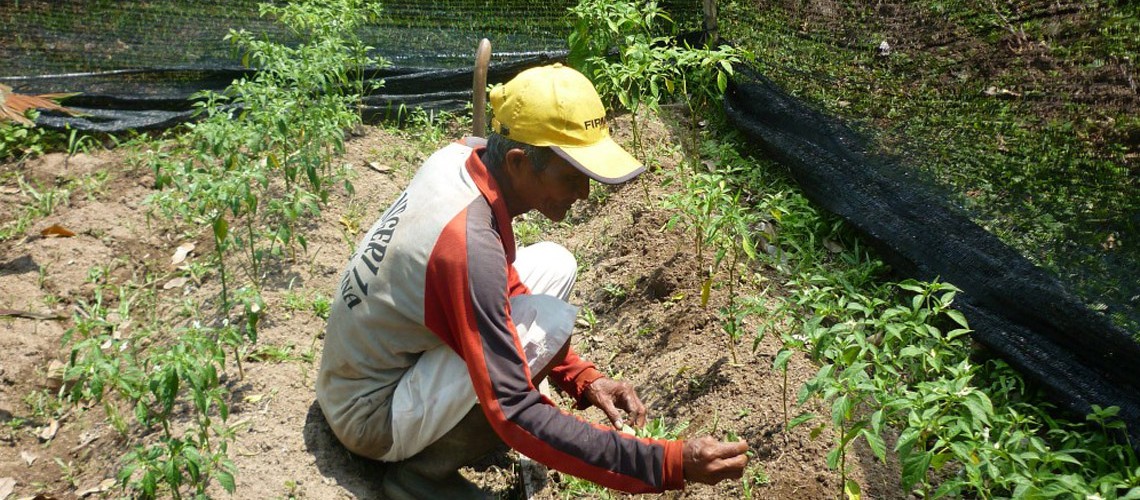By Terri Breeden, GPOCP Program Director
This month, GPOCP held its first (of many planned) activities with support from the Indonesia Climate Change Trust Fund (ICCTF). Throughout the next 18 months we will be working hand-in-hand with our recently established Customary Forest, or Hutan Desa, communities to build their capacity to sustainably manage their land. Our Customary Forest areas reside in Simpang Hilir and are made up of the villages of Nipah Kuning, Palau Kumbang, Padu Banjar, Pemangkat and Penjalaan.
It is important to note that much of the land in this region is composed of deep peatland. Peatland is rich in carbon and plays a major role in climate change. Any disturbance to this land causes release of this stored carbon into the atmosphere, which can increase the effects of climate change. With the average depth of peat in Simpang Hilir between three and four meters, it is important that members of these local communities become aware of the importance of this forest type. We want to teach them sustainable practices that will enable them to use this land to support their families while still safeguarding it. Agroforestry is a system which incorporates sustainable land use management where trees or shrubs are grown around or among crops or pastureland. This method of agriculture creates a more ecologically sound, diverse, productive and profitable land use system.
 |
|
Wendy (center) giving a lesson in the field on how to measure the depth of the peat.
|
From April 6-12th, we held a series of trainings throughout the five villages. We called these workshops, Training of the Trainer orToT for short. Our goal was to work directly with 75 local farmers, village heads and community members to build their knowledge of the potential uses of non-timber forest products (NTFPs), and to conduct coconut- and rubber-based agroforestry training. We want to build these particular members knowledge about these subjects so they can be the leaders and take initiative for these sustainable projects within their villages.
The series of trainings were implemented by Jusupta Tarigan, who goes by JT, from NTFP-EP Indonesia. He led discussions about the importance of peatlands and how to restore the areas that were devastated by the 2015 fires. The first training was held in Pemangkat and discussed peatland rehabilitation and NTFP plants. Participants were given basic materials about peat and how to restore these previously burned areas with plants such as Swamp Jelutung (Dyera polyphylla) which produces latex that can be used in chewing gum, and insulation, and the wood can be used for pulp, plywood, pencils and toys, and Shorea species that produce valuable wood. Other suitable food crops, such as coconut, cocoa and pineapple were also discussed. Pandan and rattan, valuable plants for NTFPs are also considered high worth and suitable for agroforestry within the area. On the final day of the three day training in Pemangkat, the trainees were invited to visit an area of peatland that had been burned. The trainees were able to see how the fires had impacted their land and apply all of the information they learned during the peatland workshop.
 |
|
Jusupta Tarigan, or JT, hosting a discussion about NTFPs and peat land restoration.
|
The next training was conducted in Pulau Kumbang and discussed coconut based agroforestry. This is an important topic for this community as 70% of the population are coconut farmers. JT began the course by discussing the history of forest destruction in Indonesia and explained that agroforestry has an important role in restoring the land back to pre-destruction times. He highlighted that peat areas must remain moist or wet to sustain cultivation. A way to help combat peat dehydration is to create a reservoir or pond area to store water. Often times, it also helps to plant trees outside of the peat area, so the roots can help conserve water within the peatlands. JT also suggested farmers work with two or more crops that have different harvest periods. For instance, coconuts can take up to eight years until ready to harvest, but if the farmer also plants bananas, they can have rotating crops that are ready to harvest year-round, creating a more balanced income for the farmer.
The final training was held in Padu Banjar and focused on rubber-based agroforestry. During this training JT recommended that farmers also have an alternative crop. Rubber trees have different stages at which they are ready to harvest; also the price of rubber is rather variable. If the latter situation occurs, the farmers will have other sustainable crops to harvest while waiting for the price of rubber to rise again. He recommended pineapple, jengkol (or dogfruit) or other fruit crops such as rambutan and durian.
 |
|
A group working to develop a plan on how to implement the information they learned into their community Customary Forest. All photos credit @ GPOCP.
|
All participants were also invited to develop a follow-up plan to restore the peatland and burned fields with suitable and economically productive plants. JT emphasized that it is important to restore the land with native plants, but these plants can also provide an income. This area has high potential for agroforestry and the native plants to be used can create future assets, rehabilitate the land, and they also require less labor. Agroforestry product prices are also only predicted to increase. Every participant gained valuable knowledge from their respective workshops. Each village is dedicated to creating a follow-up plan with the information learned. Wendy Tamariska, our Sustainable Livelihoods Manager stated during the closing of the series of activities, “hopefully, with this training, we will see the farmers planting economically valuable crops that can become a sustainable source of income for the community, and these plants can restore the land to reduce the threat of fire.”











